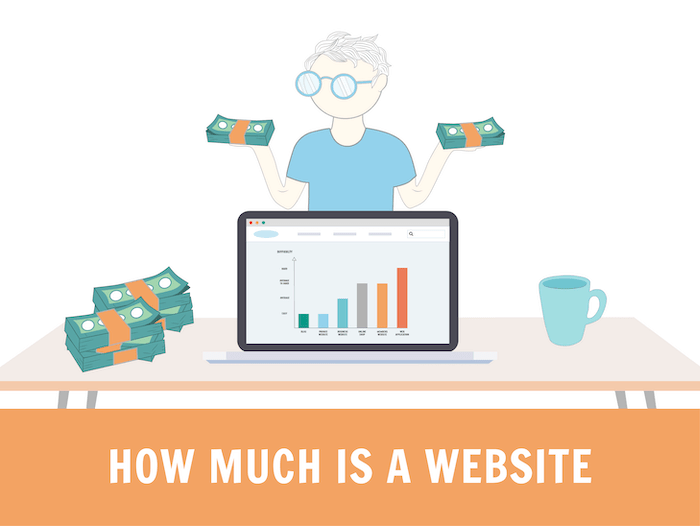Tooltester is supported by readers like yourself. We may earn an affiliate commission when you purchase through our links, which enables us to offer our research for free.
If you’ve come to this article, you’re probably not only wondering how much a website is – you probably also want to know the cheapest way to build and run a website.
Well, that’s easy. A top-notch website builder like Wix, Squarespace or GoDaddy will typically set you back around $15-20/month, with templates, hosting, and support included. At the other end of the website builder price spectrum, there are basic one-page site builders like Carrd, starting at only $9/year.
Or, using a content management system (CMS) like WordPress is technically free – you’ll just need to pay for hosting, which can cost as little as $10/month, and for themes and plugins (some of which are also available for free).
Then, for both options, you’ll want to factor in around $15/year for a domain name, and $45/year for a professional email address.
In short: you can get a great-looking website for as little as around $200-250/year.
End of story?
Not quite.
That’s because a website builder isn’t for everyone. Although they can be an affordable and convenient solution for small businesses, freelancers, and creatives, they also have their limitations.
If you want full control over your site’s design, plan to add thousands of pages or products, or want to enable more complex features (e.g. an advanced booking tool or search directory), you’ll probably need a custom-built site – that is, one that’s created from scratch by a designer and developer.
And this is when a website can get costly, ranging anywhere from $10,000 upfront to… however big your budget is.
So which solution is right for you? Can you get away with using a website builder or CMS, or do you need to invest extra in building the website you want? And how can you save money along the way?
We’ll help answer those questions, and more, in our complete guide to how much a website costs.
The three options for building a website
The three ways of building a website are:
1) Doing it yourself using a website builder
2) (Mostly) doing it yourself using a CMS like WordPress, or
3) Hiring a designer and developer to build a custom site.
So, let’s explore each one in more detail.
If you prefer info in video form, here’s a great primer on the topic:
Option 1: Website Builders
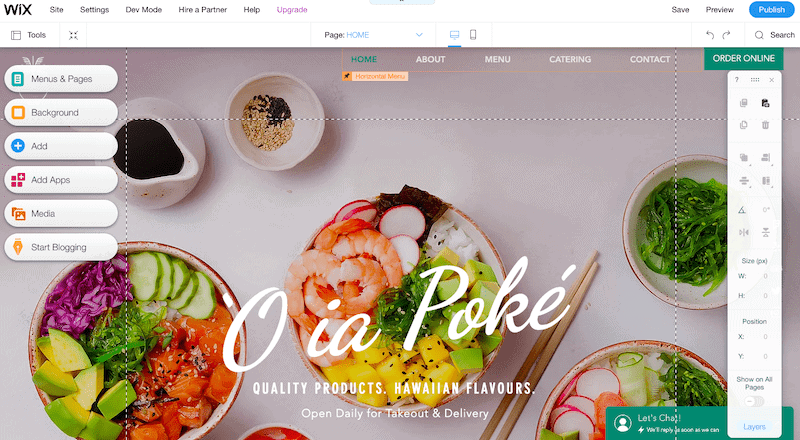
Building a website with Wix
Website builders are the easiest option for building a website, and usually also the cheapest. That’s because you’ll be using pre-designed themes and features that already come baked into the platform. A no-code editor (usually drag-and-drop), hosting, and support also come included.
This makes it ideal for small business websites, online stores, portfolios, and resume sites. The tradeoff, though, is that the customization and functionality of your website might be limited.
What’s usually not included is a domain name (although this is sometimes included for free in the first year), email accounts, and some additional features (e.g. membership areas, online booking tools).
However, you can usually purchase all these directly from the website builder provider. A little further below, we delve into how much these usually cost, so you can get an accurate estimate.
With website builders, costs are predictable. You’ll be paying either a monthly or yearly subscription (with discounts available for the latter). The more you pay, the more features you get. With Hostinger, for example, you can have a basic website for around $3.19/month, but upgrade to access ecommerce features for $4.99/month. (Note – Hostinger are one of the cheapest website builders in the market, but you’ll be paying more for premium website builders like Wix or Squarespace.)
Some website builders even offer free plans. However, they usually display the website builder’s branding/ads, and won’t let you use your own domain name. So, we generally only recommend them for trying the platform out.
Check out these examples of real websites build with website builders like Wix, Squarespace, Hostinger, to give you an idea of what kinds of sites they typically support.
Or, jump below to dive into the costs associated with using a website builder.
Pro tip: Our entire website is dedicated to helping you find the best website builder. So if that’s the right way for you, do spend a bit of time exploring and checking out our comparison tool, in-depth reviews, and videos!
Option 2: Content Management Systems

Many blogs, such as the TED Blog, are created with WordPress
A CMS like WordPress offers a good middle-ground between a website builder and fully custom-built site. It allows for more customization than a website builder, with the ability to edit your theme code, and choose from a huge range of plugins and features. As a result, a CMS can be extremely powerful, but has more of a learning curve than your regular website builder.
CMSs are ideal for larger sites, highly-trafficked blogs, and medium-to-large online stores. Our website, for example, is built on WordPress, as well as popular sites like TechCrunch, Vogue, and Rolling Stone.
Although the WordPress platform is free to use, you need to factor in a few costs – namely:
- Setup costs – these usually include purchasing a theme and plugins, although some of these are available for free. Costs will vary depending on your requirements (see our cost estimate table below for more details). You might also want to hire a designer or developer if you’re after a more customized or complex site.
- Ongoing costs – these include hosting, domains, security, and plugin subscriptions (e.g. for the WooCommerce or Ecwid plugins, which let you sell online). WordPress don’t generally provide these (unless you’re using their hosted service, WordPress.com), so you’ll have to source them from various providers.
You can keep costs down by choosing a cheap WordPress hosting provider and keeping the functionality simple (this option usually ends up being cheaper than a website builder).
However, costs can add up when you add customizations and features, or opt to use a designer or developer. A little further below, we explore the different options you can take (and how much they typically cost).
While you don’t need to know how to code to use a CMS, it definitely helps to have some technical knowledge. You also need to be prepared to invest some time in maintaining your site’s security and plugins, and dealing with the relevant providers if something goes wrong with your site.
We explore how much you’re likely to spend if you use a CMS a little further below.
Option 3: Custom-Built Site
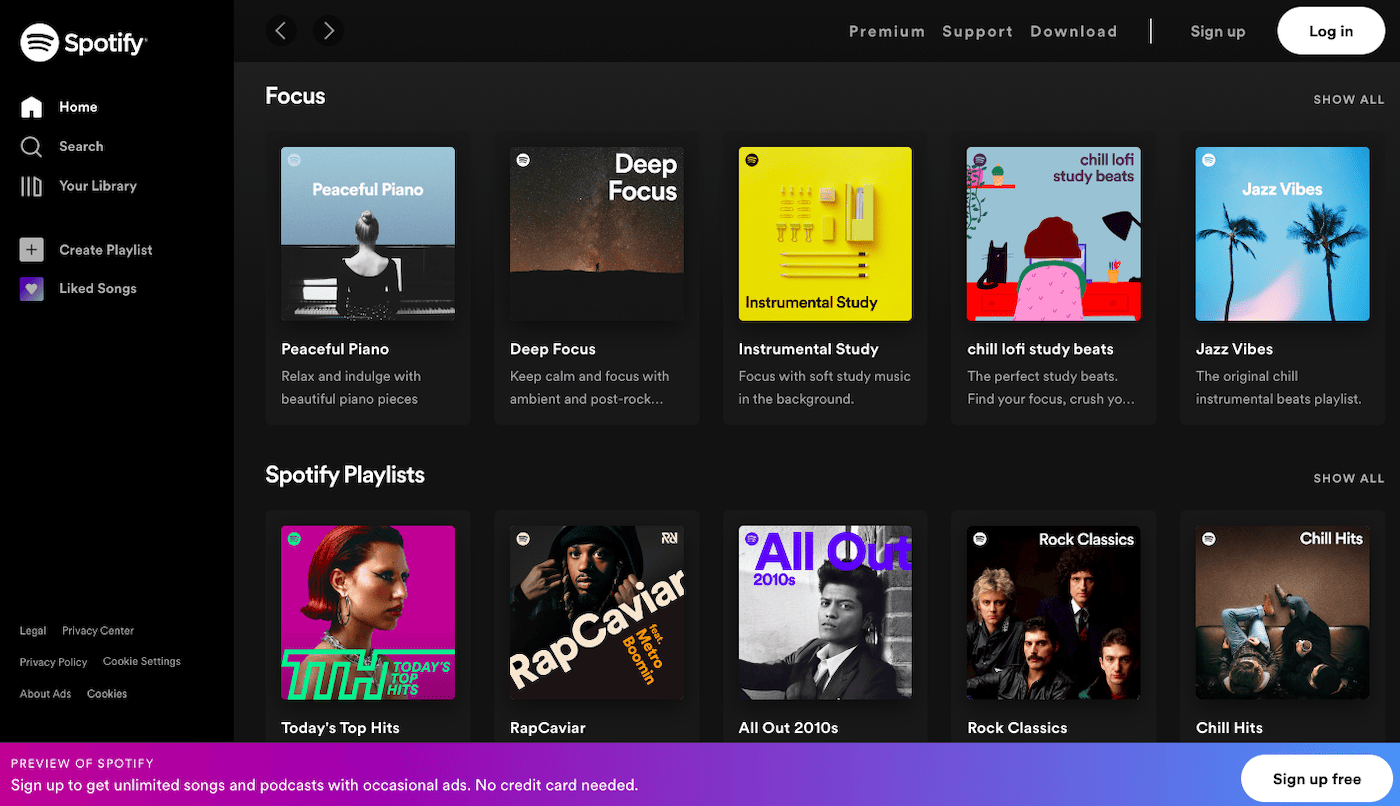
The Spotify website is an example of a custom-built site
Custom-built sites are the most expensive option, and can cost several thousand dollars (or more). That’s because you’ll be hiring a designer and developer to code your site from scratch using HTML, CSS and Javascript code, tailored to your specific requirements.
The majority of small-to-medium businesses probably won’t need this kind of site. Instead, they’re usually for tech startups or businesses who want to build a web app, tool, or online service (think websites like Airbnb, Craigslist, or Udemy).
Because you’re building such a unique site, the bulk of your costs will be the hours put in by the design and development teams. Further below, we share some suggestions on where to hire these resources, and the associated costs.
The initial expenses for a custom-made website are usually high, usually starting at around $10,000 (our own Tooltester website relaunch fell into this sort of budget). After the site is launched, the ongoing expenses for domain, hosting, support, and maintenance tend to level off. However, these costs may increase again if you plan to make frequent changes or add new features to the site, so it’s important to consider this in your budgeting.
A breakdown of website building costs
So now we know the different approaches you can take when building a website.
Now, let’s see exactly how much you can expect to pay for each. Costs will vary depending on the kind of site you’re trying to build, so let’s compare a basic blog, small business website, small online store, and complex web app:
| APPROACH | BASIC BLOG | SMALL BUSINESS WEBSITE | SMALL ONLINE STORE | COMPLEX WEB APP |
|---|---|---|---|---|
| Website builder (e.g. Wix) | $0 with ads – $15 per month without
$15 a year for custom domain $45 a year for professional email address 2-6 hours to setup 2 hours per post |
$25 per month
$15 a year for custom domain $45 a year for professional email address 6-12 hours to setup 10 – 25 hours a month on updates |
$30 per month.
$15 a year for custom domain $45 a year for professional email address 6 – 12 hours to setup 30 – 90 hours a month managing |
N/A |
| CMS (e.g. WordPress) | $70 – $140 per year on hosting
$15 a year for domain name $45 a year for professional email address 1 – 3 days to get started 2 hours per post |
$70 – $140 per year on hosting
$15 a year for domain name $45 a year for professional email address Premium theme: $60 – $200 one-off fee. 2 – 7 days to setup 12 – 30 hours a month on updates |
$100 – $250 per year on hosting
$15 a year for domain name $45 a year for professional email address $10 per year for SSL security (for payments) WooCommerce plugin: $0 – $180 depending on features 2 – 7 days to setup 30 – 90 hours a month managing |
$100 – $250 per year on hosting
$15 a year for domain name $45 a year for professional email address Premium theme: $60 – $200 one-off fee. Premium plugins: $200-$1000 one-off fee. 7 – 14 days to setup 0 – 90 hours a month managing |
| Custom development | $500 – $1000 initial fee
$70 – $140 per year on hosting $14 a year for domain name 2 – 7 days to setup 2 – 4 hours per post if you can’t upload yourself |
$1000 – $3000 initial fee
$70 – $140 per year on hosting $14 a year for domain name 2 – 7 days to setup 12 – 30 hours a month on updates |
$1000 – $5000 initial fee
$70 – $140 per year on hosting $14 a year for domain name 7 – 14 days to setup 30 – 90 hours a month managing |
$3000 – $5000 initial fee
$70 – $140 per year on hosting $14 a year for domain name 14 – 30 days to setup 0 – 90 hours a month managing |
By now, you hopefully have an idea around which avenue you want to take. So, let’s explore each one in more detail, and find out how you can get costs down.
Pro tip: Since you’re going to have to pay for a domain name eventually, do check out the available options as soon as possible (a good place to do that is Namecheap). You’d be surprised how many businesses have to change their names because the domain is too expensive or unavailable.
And don’t forget to experiment with more obscure domain extensions. They can be more affordable, and a fun way to make your site name memorable. For instance, if SellingShoes.com is unavailable, you could snatch Selling.shoes at a fraction of the price.
A deeper dive into the costs – and how you can save money
Option 1: Taking the easy route with website builders
As we’ve seen, website builders are an affordable way to build a website site, with most features (hosting, security, templates etc.) included in their monthly/annual subscriptions.
Earlier, we mentioned that you can get a website built with a website builder for around $240/year. But, depending on the features you need, your website might actually cost more – or even less – than this.
So, let’s take a look at our best-ranked website builders for a personal site or blog, and compare the costs. Further down, we’ll also take a look at the best website builders for business sites, and for online stores.
Website builder cost comparison: Personal sites and blogs (prices shown in USD)
| Wix | Squarespace | GoDaddy | Hostinger | Webnode | |
|---|---|---|---|---|---|
| Subscription to cheapest plan (billed annually) | $16 / month for Light plan | $16 / month for Personal plan | $11.99 / month (plus discount in first year) for Basic plan | $3.29 / month for Website plan (you can also get a 10% discount here) | $7.50 / year for Mini plan |
| Domain | Free in first year, from $15 / year thereafter* | Free in first year, from $20 / year thereafter* | From around $20 / year* | Free in first year, from $7 / year thereafter* | Free in first year, from $15 / year thereafter* |
| Email address | $6 / month per email address with Google Workspace | $6 / month per email address with Google Workspace | Free in first year with Microsoft 365 Email, then from around $6 / month per email address | Free for 3 months, then $2.90 / month per email address | Included for free on most plans |
| Approximate yearly cost | $279 / year | $284 / year | $238.88 / year | $81.28 / year | $105 / year |
* Note: The domain costs shown are for the lowest-tier domains available – popular domain names and those with niche extensions (e.g. .ai or .io) tend to cost more.
First things first. You’ve probably noticed the vast difference in subscription fees for some of these providers. For instance, why are Hostinger and Webnode’s prices so much lower than Wix and Squarespace’s?
In general, with premium providers like Wix and Squarespace, you’re paying for a wider range of better-quality templates, and more comprehensive features. Wix and Squarespace, for example, offer advanced blogging features, (paid) membership areas for your website, and podcast integrations, whereas Hostinger and Webnode only offer the most basic functionality for simple sites.
However, one thing that’s common to all website builders is that you have a few basics included in your subscription. Apart from hosting, you’ll also get a few gigabytes of storage (although some providers, like Squarespace, offer unlimited storage), SSL certificate, and support.
Now, here are the ways you can cut these costs down even further:
- Opt for annual plans – Discounts are usually offered for longer subscription periods – sometimes up to 30%. If you’ve tried out the website builder and are convinced it’s the right one for you, it pays to sign up for an annual (or even bi-annual) subscription.
- Get your domain elsewhere – Providers like Namecheap offer much cheaper renewal prices. Of course, you could always take advantage of the website builder’s free first-year offer, then move your domain to another provider just before renewal is up.
- Choose cheap (or even free!) providers for email – While Google Workspace is a popular option, it’s not the most budget-friendly. If you’ll be needing multiple mailboxes, using alternatives like Namecheap or Zoho instead can save you hundreds each year
But what if you run a business and need extra features, such as appointment booking, member areas, and email marketing? Let’s run those costs.
Website builder cost comparison: Business websites (prices shown in USD)
| Wix | Squarespace | GoDaddy | Hostinger | Webnode | |
|---|---|---|---|---|---|
| Subscription to cheapest Business plan (billed annually) | $27 / month for Core plan | $23 / month for Commerce plan | $21.99 / month for Premium plan (plus discount in first year) | $4.99 / month for Business plan (you can also get a 10% discount here) | $24.90 / year for Profi plan |
| Domain | Free in first year, from $15 / year thereafter | Free in first year, from $20 / year thereafter | From around $20 / year | Free in first year, from $7 / year thereafter | Free in first year, from $15 / year thereafter |
| Email address | $6 / month per email address with Google Workspace | $6 / month per email address with Google Workspace | Free in first year with Microsoft 365 Email, then from around $6 / month per email address | Free for 3 months, then $2.90 / month per email address | 100 email accounts included for free |
| Appointment booking tool | Included for free with Wix Bookings | From $14 / month with Squarespace Scheduling | Included for free | Included for free | Simple booking form included for free |
| Email marketing | From $10 / month with Wix Ascend | From $5 / month with Squarespace Email Campaigns | 25,000 email sends per month included for free | Not available | Not available |
| Members area | Included for free | From $9 / month with Squarespace Member Areas | Not available | Not available | Basic membership features included for free |
| Approximate yearly cost | $531 / year | $ 704 / year | $ 355.88 / year | $ 101.68 / year | $ 313.8 / year |
Pricing for business websites tend to be more expensive than for personal websites, as they usually include more features. Once again, we’re seeing some very cheap plans (e.g. Hostinger’s), and some significantly pricier options.
But choosing the right website builder for your business website should be about more than just picking the cheapest option. For example, Squarespace and Wix’s appointment booking tools and membership features are much more comprehensive than their competitors’, so if most of your business is online, the extra investment might be worth it.
However, the advantage of Wix over Squarespace is that a lot of their business tools are included for free, lowering overall costs. There’s even a free version of their Wix Ascend business toolkit, giving you access to email marketing, CRM, live chat, and more.
Most website builders don’t include email accounts as part of their packages, but Webnode is the exception. With 100 mailboxes included in the Profi plan, it’s an interesting option if you’re looking to save on email costs (and don’t mind having a less flashy-looking website in return).
If you are looking to create a business website, another key way to save money is to choose a low-cost email marketing provider. Wix and Squarespace’s email marketing tools are basic at best, lacking key features like marketing automation and advanced segmentation. You’ll find more advanced email marketing services like MailerLite and Brevo offer better value for money (and can even be used for free).
What if you’re trying to sell products or services online? Let’s take a look at website costs for our top five all-in-one ecommerce website builders.
Website builder cost comparison: Online stores (prices shown in USD)
| Shopify | BigCommerce | Wix | Squarespace | Weebly | |
|---|---|---|---|---|---|
| Subscription to cheapest Ecommerce plan (billed annually) | $29 / month for Basic plan | $29.95 / month for Standard plan | $27 / month for Core plan | $27 / month for Commerce Basic plan | $12 / year for Professional plan |
| Domain | Around $15 / year | Around $15 / year | Free in first year, from $15 / year thereafter | Free in first year, from $20 / year thereafter | Free in first year, from $20 / year thereafter |
| Email address | $6 / month per email address with Google Workspace | $6 / month per email address with Google Workspace | $6 / month per email address with Google Workspace | $6 / month per email address with Google Workspace | Included for free on most plans |
| Approximate yearly cost | $435 / year | $446 / year | $411 / year | $416 / year | $236 / year |
As we can see, there are some affordable options for running an online store with a website builder. Shopify and BigCommerce are on the pricier end of the scale, but as ecommerce-focused website builders, they offer more specialized features (e.g. for managing taxes, shipping, payment methods and inventory) than the other providers. They are also better built for supporting larger online stores.
One thing that’s not included in these calculations are transaction fees and payment processing fees. While most of these providers do away with transaction fees (with the exception of Shopify, if you’re not using their Shopify Payments solution), all of them charge online payment processing fees, which are around 2.4% + 30¢ per transaction.
You may also need to upgrade to higher-level plans to access certain features, e.g. advanced reporting, third-party shipping rates, automated sales tax etc. BigCommerce’s pricing tiers are also based on annual revenue, and they’ll automatically bump you up to the next plan if you hit the threshold, so you’ll need to keep that in mind if you’re using their solution.
Option 2: Rolling up your sleeves with a CMS
If you need more control over your website’s design than a website builder can provide, your next best bet is to opt for a CMS like WordPress. WordPress gives you access to a huge range of themes and plugins, allowing you to create feature-packed business websites, powerful online stores, affiliate websites, content-rich blogs, and more.
This flexibility has helped WordPress become the world’s most popular website building platform, powering 43.2% of all the internet’s websites.
The great news is that, if you opt to do it all yourself, a CMS can be a relatively cheap way of building a website, especially as the software itself is free to download and use. We explored the potential costs earlier, but here are a few other tips for keeping your costs down:
- Choose a cheap WordPress hosting provider: Essentially, you can install WordPress on any hosting service that provides support for PHP and MySQL. The process is even simpler if your host offers a WordPress-specific package. These plans typically start at around $4 to $7. Often, a domain name and email addresses are included in these plans as well. From personal experience, we can recommend Dreamhost and A2.
- Consider using WordPress.com for a personal website (but not a business one): WordPress also offer their own hosted service, WordPress.com, with a limited free plan and affordable pricing for personal websites. It’s not the most economical option for business or ecommerce sites, though.
- Purchase a theme (rather than designing one from scratch): You can buy nice-looking premium templates at reasonable prices on websites like Themeforest, Themeisle (who also offer decent free themes), or Elegant Themes – prices start at $30-60 for a one-time payment. When choosing a template, consider: popularity (more buyers = better support), reviews (check for problems), and mobile responsiveness.
- Find affordable (or even free) plugins: With a little research, you can often find reputable plugins for a very good price. For example, the free version of Yoast SEO covers most of your optimization needs. And for selling online, you can get started with the free version of the WooCommerce plugin.
If, however, you decide you need the help of a designer or developer, that’s when things start to get pricey. And that’s what we explore in greater detail in the next section.
Option 3: Getting a custom site designed and built by professionals
If you want to hire a developer – whether to build a site using WordPress, or one completely from scratch – it helps to have a strong idea about how you want the website to look and feel beforehand. They won’t be able to read your mind so do your research and find examples of similar sites.
But first, the website layout should ideally be created by a professional designer as things often go wrong when web developers branch out into web design. And yes, you guessed it, that’s an additional expense.
Pro tip: It never hurts to have a clear idea of the results you want to achieve before you get started. Put together a shortlist of sites that closely resemble what you want yours to look and feel like.
Examples will make the design process much faster, whether you do it yourself, with a website builder, or even if you pass them to a designer/developer.
If you have a friend who has website design experience and is prepared to charge you mates’ rates, great! That can be a useful way to get your website design put together – provided you’re both on the same (web)page 😉.
But if this isn’t an option, we can recommend the following online sources to help you find an affordable professional designer:
- 99designs: Run a design contest and receive submissions from multiple designers. Web design packages start at $599 (read our full 99designs review here)
- Fiverr: Hand-pick your own web designer and hire them at a very affordable rate (average of $150/page – read our full Fiverr review here)
- Upwork: Get access to a huge pool of designers (and developers, too). Rates tend to average between $15-75/hour
Note that with these sites, skill and experience levels vary, and the more seasoned designers tend to charge more. However, with a bit of time invested into reviewing portfolios and speaking to different designers, you can still get a very good deal.
Pro Tip: We share a few tips on how to work with a web designer in this article.
Once your design is locked down, it’s time to get started on building the final website. Web developers, whether they work as freelancers or as part of an agency, can give you wildly fluctuating quotes.
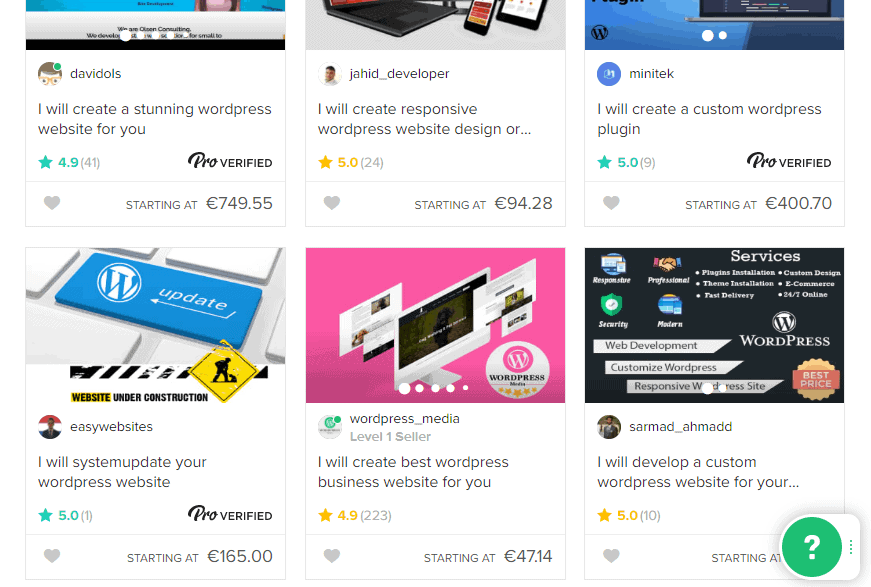
Screenshot from Fiverr.com
They can usually be hired:
- On an hourly fee: where you monitor how much work they do. It’s good for ad hoc updates and changes to your websites as things go along. The range can be from $10 – $200 per hour, depending on their skill and experience. And the website could take between 50 – 300 hours to make depending on the complexity.
- Per contract: you hire them for a complete website. Let’s say between $1000 – $3000 as a rough estimate. You need to make sure you are the owner of the source code if you need to make changes later. Also try to include a few revisions in the price in case something goes wrong. We, for example, hired an agency for our website relaunch, which cost us a fixed 5-figure amount.
An average timeline for custom web development will look like this:
- Pre-planning: maybe 2 days (16 hours). The developer will collect information about your needs and discuss ideas.
- Collecting resources: finding the right tools and examples to get started. Maybe another 3 days (24 hours).
- Actual building: let’s say one working week (40 hours).
- Testing: 2 or 3 days to make sure everything works smoothly (16 – 24 hours).
And that’s for a medium-sized, not too complex website. More complex ones can take several months, or even a year.
So it can be very expensive. But you can also ask around to see if anyone you know will help. Just make sure you don’t blindly trust anyone – we’ve heard of situations where family and friends were commissioned and everything ending in a big argument.
From our experience, the most convenient way is to post your project on a portal like Upwork, Codeable or Toptal. You simply describe your job and will then get a (non-binding) quote from a web developer. The great thing is that you can view their ratings before hiring someone.
If you want to build an online store with Shopify, Storetasker would be your best bet. These platforms are very selective with their developers, so you can expect only serious offers.
Pro Tip: As with any kind of job, spending a bit getting to know your developer will go a long way.
So do check portfolios and references, ask for at least three quotes, check ratings (if available), and try to meet them in person (or speak on the phone or on Skype) to check availability and timescale, and that there are no communication issues.
Which option is right for me (and how much should I spend)?
The route you choose should be completely influenced by the kind of website you want to create. It can be as simple or complex as you want it to be. And here, there are four main concepts that can help you guess how much time, effort and money goes into each one:
- Behavior: This is what the website does. At its most basic, it shows text and clickable links that take you to other pages (e.g. a portfolio site for a photographer). That’s good enough for most, and very easy to do with a website builder. On the other end, it can be a full web application like a flight comparison website that uses APIs and all kinds of complex interactive tools, which will need the help of a developer.
- Content: Here again, your website can just display a few sentences about your mom and pop shop. Or it can be a full on multimedia experience with videos, streamed audio and AR tools. As you can guess, the latter is likely to cost more, and may need a custom solution.
- Design: Website builders offer pre-designed templates that are customizable and don’t need a lot of tweaks to look great. But what if none fit your design vision? You’ll either need to create your own, or hire a designer to create one for you.
- Depth: a.k.a navigation levels. Put simply, a basic website will just work with one “landing page” on a main URL. A complex website will need multiple subdomains to structure and organize all the content. Most website builders are only designed to support simple navigation structures (e.g. one sub-level). Any more than that and you’re likely to need a CMS or custom solution.
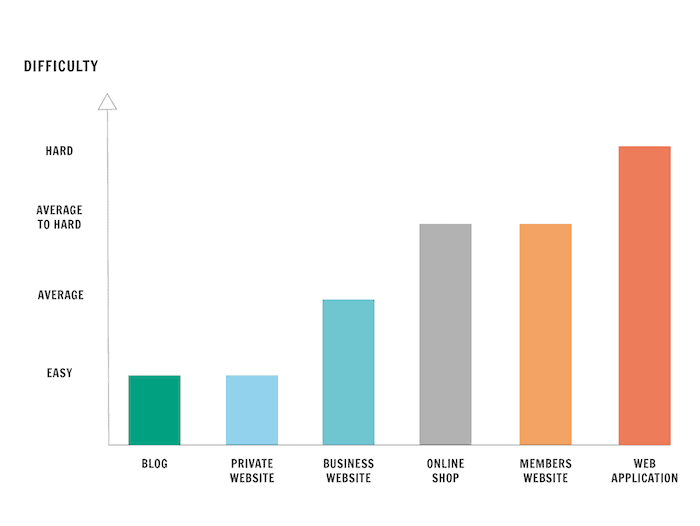
The more complex a website is, the more money you’re likely going to need to spend. It’s worth noting though that a blog, online shop, and members website can all be built by a website builder
Now just because a website looks simple doesn’t mean it was fast or cheap to make. For instance, Wikipedia.org doesn’t have a fancy design. But the sheer amount of content and depth means it costs millions of dollars a year to maintain.
A website like isitmonday.today also looks deceptively simple. No crazy content or design, but there is a smart script that checks the date – so definitely needed custom coding.
And another good example, the world famous Craigslist. Basic design, simple text and images. But… users can login and post classifieds directly like on a forum, which isn’t all that easy to do.
Now for a counter example, check out this Barbershop website built with Wix. There is an Instagram feed, video integrations (from YouTube), an online booking form, and even a small online store section. Had they hired a developer to build it a few years ago, it would have cost between $5 – 10K.
Today, I’m going to guess they use the Business Unlimited plan, so around $25 a month. Hosting is included, and the domain costs around $15 a year to keep after the first free year.
Pro tip: Website complexity is usually a tradeoff between features and user experience. You want your users to find and do things as easily as possible on your site, so if you can choose the simpler option, always go for that one.
Also keep in mind that your plans can change. For instance, we created the original Tooltester site using Webnode, a website builder. But after a few years, we had to switch to a system that offered more flexibility. We ended up going for WordPress as we needed a few special features, such as our direct comparison tool. We just couldn’t use one of the standard website builder designs for that.
Now did we regret using that website builder? Definitely not. Who knows if we would have ever started the site if it hadn’t it been for the ease of use of the Webnode website builder.
Pro tip: Think about what you want your website to do now – but also in the future. Will you want to add more features later? Will you want to be able to change the design? And how much content will you add to it down the line?
How Much is a Website: Final Thoughts
So as you can see, a website can cost anything. You can spend $0 up to… well, anything you want.
But if there’s one you should take away from this mammoth post, it’s that while website costs do vary, but they shouldn’t be hard to understand.
Hopefully, this guide will help you decide how much it makes sense to spend, and what to expect in return! Let me know if anything is still unclear.
Want to know more about how much a website costs? Let us know your questions in the comments below!
We keep our content up to date
28 Aug 2023 - Updated prices
15 Feb 2023 - Complete update with new prices
16 Dec 2021 - Some pricing updates
THE BEHIND THE SCENES OF THIS BLOG
This article has been written and researched following a precise methodology.
Our methodology